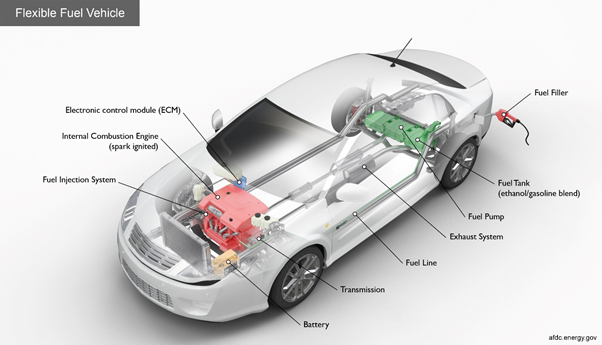

Context
Toyota recently unveiled a prototype of the Innova Hycross with a flex-fuel hybrid powertrain, its first car in India with this option, and one that the Japanese carmaker claims is the world’s first BS6 Stage II-compliant flex-fuel vehicle.
What is flex fuel technology?
- A flex fuel, or flexible fuel, vehicle has an internal combustion engine (ICE), but unlike a regular petrol or diesel vehicle, this can run on more than one type of fuel, or even a mixture of fuels.
- The most common versions use a blend of petrol and ethanol or methanol, but these engines are also equipped to run on 100 per cent petrol or ethanol as well.
- This is made possible by equipping the engine with a fuel mix sensor and an engine control module (ECM) programming that senses and automatically adjusts for any ratio of designated fuels.
- It was first developed in the early 1990sand used in the mass-produced 1994 Ford Taurus, according to Car Bibles. By 2017, there were approximately 21 million flex-fuel vehicles on the road.
|
Hycross prototype
|
Key Components of a Flex Fuel Car
- Battery: The battery provides electricity to start the engine and power vehicle electronics/accessories.
- Electronic control module (ECM): The ECM controls the fuel mixture, ignition timing, and emissions system; monitors the operation of the vehicle; safeguards the engine from abuse; and detects and troubleshoots problems.
- Exhaust system: The exhaust system channels the exhaust gases from the engine out through the tailpipe. A three-way catalyst is designed to reduce engine-out emissions within the exhaust system.
- Fuel filler: A nozzle from a fuel dispenser attaches to the receptacle on the vehicle to fill the tank.
- Fuel injection system: This system introduces fuel into the engine's combustion chambers for ignition.
- Fuel line: A metal tube or flexible hose (or a combination of these) transfers fuel from the tank to the engine's fuel injection system.
- Fuel pump: A pump that transfers fuel from the tank to the engine's fuel injection system via the fuel line.
- Fuel tank (ethanol/gasoline blend): Stores fuel on board the vehicle to power the engine.
- Internal combustion engine (spark-ignited): In this configuration, fuel is injected into either the intake manifold or the combustion chamber, where it is combined with air, and the air/fuel mixture is ignited by the spark from a spark plug.
- Transmission: The transmission transfers mechanical power from the engine and/or electric traction motor to drive the wheels.

How flex fuel cars work?
- Flex fuel vehicles have one fuel system, and most components are the same as those found in a conventional petrol-only car.
- Some special ethanol-compatible components are required to adjust to the different chemical properties and energy content in ethanol or methanol, such as modifications to the fuel pump and fuel injection system.
- The ECM is also calibrated to accommodate the higher oxygen content of ethanol.
|
Advantages of Flex-Fuel |
Disadvantages of Flex-Fuel |
|
|


